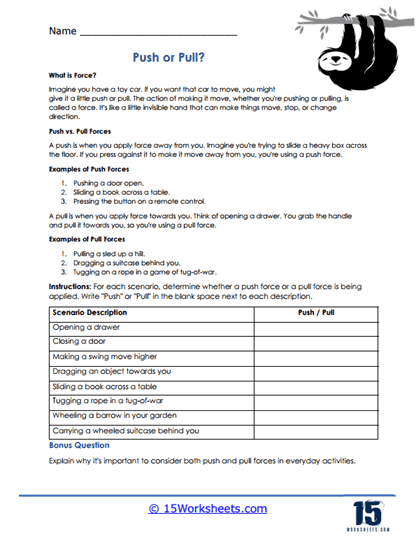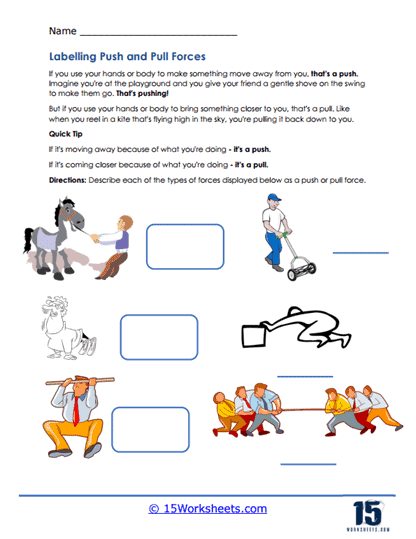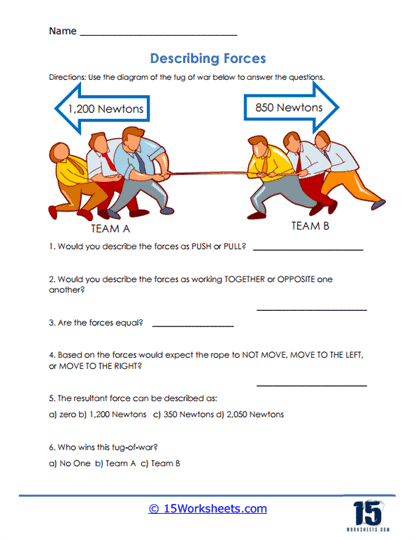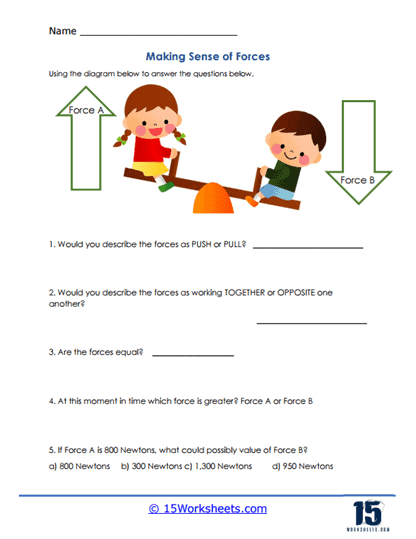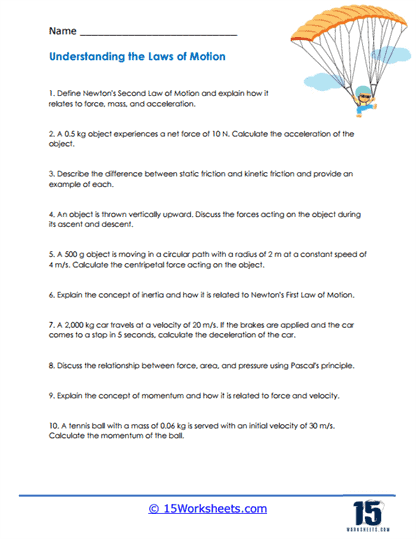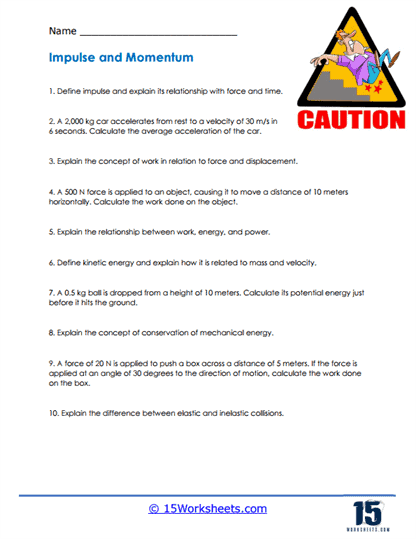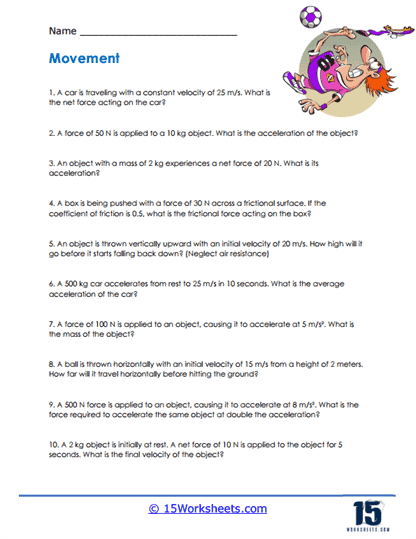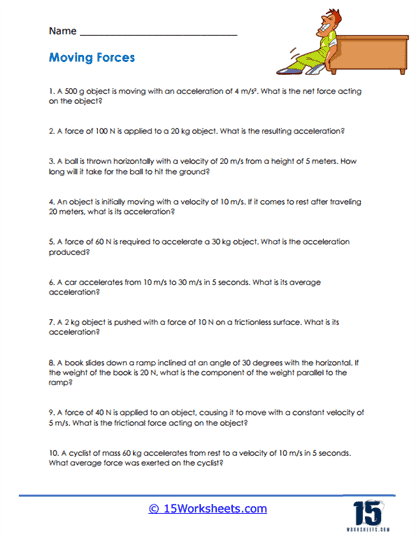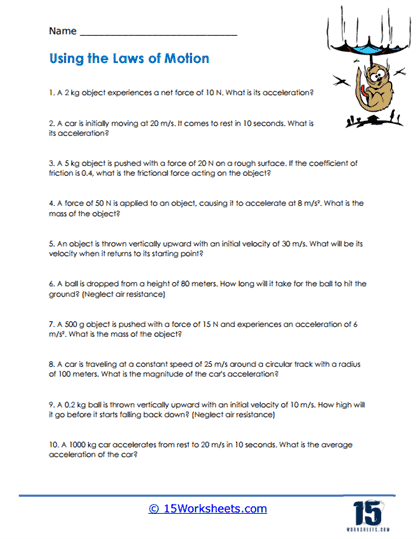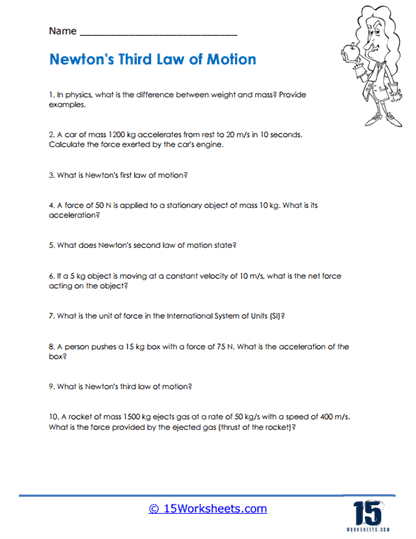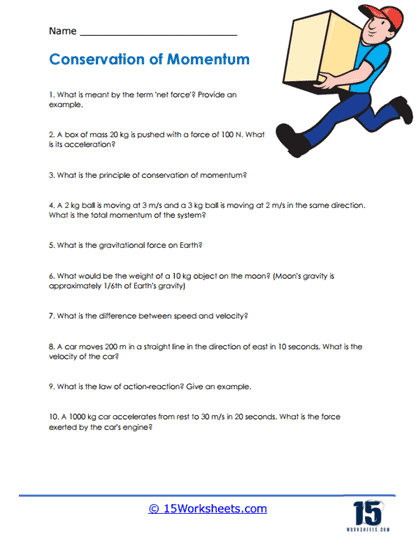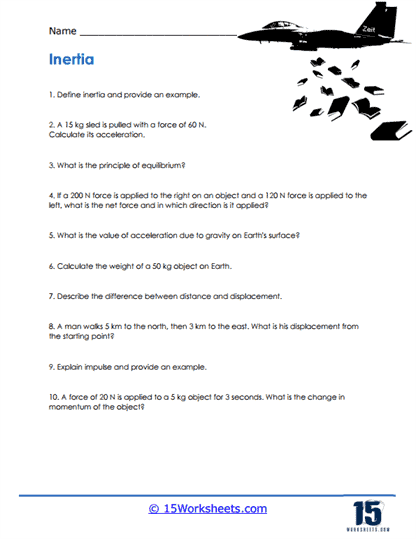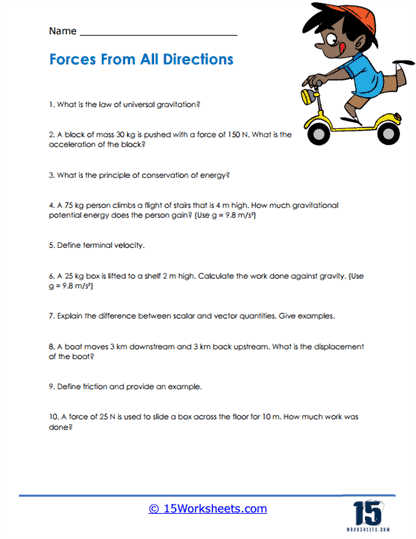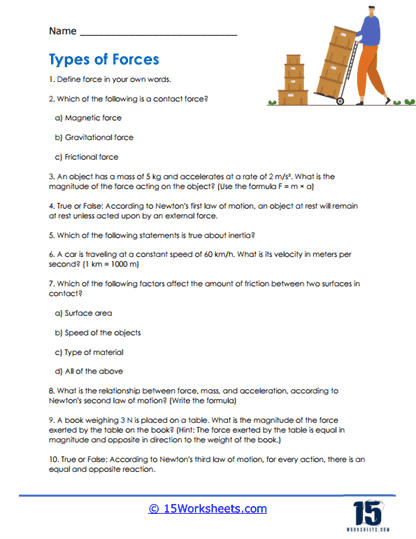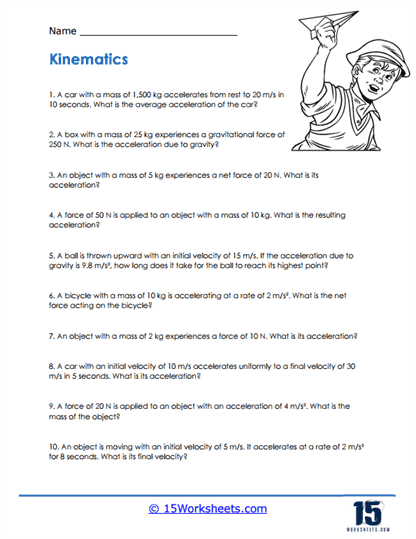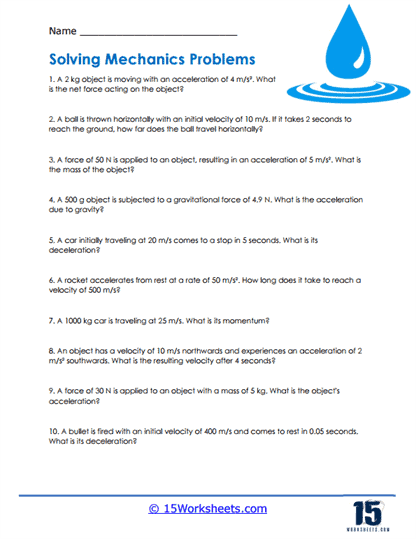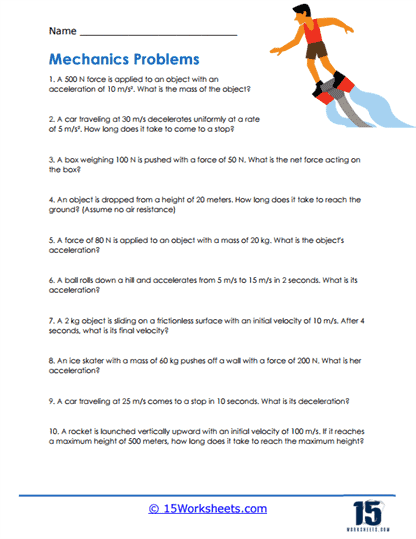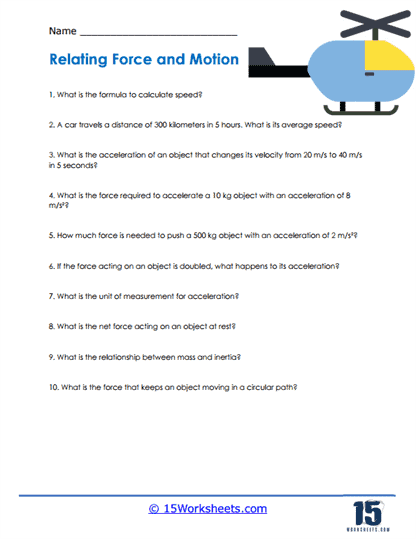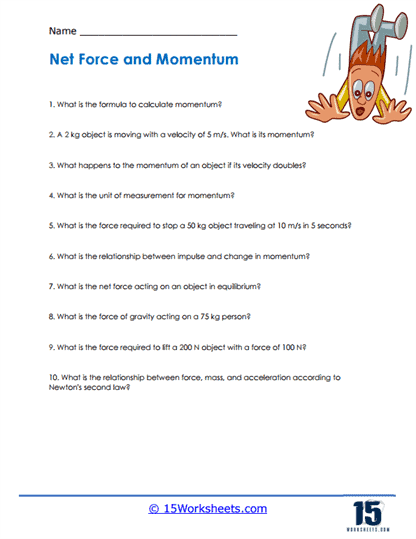Forces and Motion Worksheets
About These 15 Worksheets
Understanding the fundamental principles of physics is more than just memorizing formulas and definitions; it’s about exploring the forces that shape our world and the intricate dance of motion that governs everything around us. Physics, at its core, unravels the mysteries of how objects interact, how energy is transferred, and how forces propel, resist, and balance each other. It’s a fascinating realm where the abstract becomes tangible and where theory and reality intersect in profound ways. That’s why using targeted, thoughtfully designed worksheets can make a world of difference when it comes to grasping these concepts.
By focusing on topics like forces, motion, and the interactions between objects, these resources aim to transform the classroom into a dynamic space where students become explorers, testing the boundaries of their understanding and challenging their preconceptions about the physical world. Instead of passively absorbing information, students are encouraged to dive into scenarios that mimic real-life applications of physics principles, bridging the gap between theory and practice.
The key to effective learning lies in active participation. Our worksheets are crafted to spark curiosity and foster a hands-on approach to studying physics. Each worksheet is designed not merely as a set of problems to be solved but as a journey into the mechanics of everyday phenomena—why a ball thrown in the air follows a parabolic trajectory, how friction plays a role in slowing objects down, or why two objects of different masses fall at the same rate in a vacuum. By immersing students in these experiences, the worksheets encourage them to think critically and develop a deeper, more intuitive understanding of the laws that govern the universe.
These worksheets serve multiple purposes. Firstly, they reinforce theoretical concepts by allowing students to see them in action. For example, after learning about Newton’s laws of motion, students are presented with scenarios where they can apply these laws to predict outcomes, analyze the forces at play, and understand how motion changes when different variables are altered. This active application not only solidifies their grasp of theoretical knowledge but also enhances their problem-solving skills—an essential component of mastering physics.
These worksheets are crafted to promote a deeper, self-directed learning experience. By presenting challenges that require more than just rote memorization, they compel students to synthesize information, think logically, and approach problems from multiple angles. Each worksheet is an invitation to experiment with different methods, question assumptions, and explore the relationships between different physical variables, ultimately leading to a richer and more comprehensive understanding of the material.
Another crucial aspect is the variety these worksheets offer. Understanding forces and motion isn’t just about pushing objects or calculating acceleration; it’s about appreciating the vast interconnected web of phenomena that physics explains. Some worksheets might focus on simple tasks like calculating velocity, while others might present complex systems, such as the mechanics behind roller coasters or the physics of space travel. This diversity not only keeps students engaged but also shows them the wide range of applications of physics, highlighting its relevance in both everyday life and cutting-edge technology.
Types of Problems On These Worksheets
Identifying Types of Forces – These problems will present different scenarios, and students will need to determine the type of force at work. For example, “When you pull a door open, what kind of force are you using?” The answer is a “pulling force”. Students learn to identify forces like gravity (what keeps us on the ground), friction (what makes it hard to slide on carpet), and tension (like in a stretched rubber band).
Calculating Force – Here, students might be given the mass (how much matter is in an object) and acceleration (how fast something is speeding up) of an object and asked to calculate the force using Newton’s second law (Force = mass x acceleration). For instance, “If a car has a mass of 1,000 kilograms and accelerates at 2 meters per second squared, what is the force?” This teaches students to apply formulas and understand the relationship between mass, force, and acceleration.
Understanding Motion – These problems might ask students to describe the motion of an object. For instance, “If a ball is rolling down a hill and then rolls on a flat surface, what happens to its speed?” Here, students will learn that the ball speeds up when going downhill (due to gravity) but slows down on a flat surface (because of friction).
Predicting Outcomes – Some questions will present scenarios and ask students to predict what will happen based on their knowledge of forces and motion. For example, “If you were to slide down a slide covered in sandpaper versus one that’s smooth, which one would slow you down faster?” Students would use their understanding of friction to predict that the sandpaper slide would slow them down more.
Comparing and Contrasting – Here, students might be asked to compare two different forces or types of motion. For example, “How is the motion of a bicycle different from the motion of a spinning top?” With such questions, students learn to think critically and distinguish between different concepts in forces and motion.
Real-world Applications – These problems connect what students learn about forces and motion to the real world. They might be asked, “Why do you lean forward when a bus suddenly stops?” Through this, students realize that the concepts of forces and motion are not just textbook ideas but are happening all around them every day.
What is Force?
Force is one of the most fundamental concepts in physics, and yet, it’s something we encounter in every moment of our lives, often without even realizing it. At its core, force is a push or a pull exerted on an object, causing it to move, stop, or change direction. Imagine it as an invisible hand that interacts with everything around you, shaping the way objects behave and react. Every time you engage with the world, you’re applying or experiencing force. But force isn’t just limited to simple pushes and pulls; it’s the essential cause behind every movement we observe.
Picture yourself playing tug-of-war with your friends. As you grip the rope and pull with all your strength, you are applying a force that competes against the force exerted by your opponents. This interaction illustrates how forces can work in opposition, creating tension and resistance. It’s not merely about winning or losing; it’s about the physics behind the struggle. The force you apply stretches through the rope and meets the opposing force, demonstrating the dynamic nature of these invisible yet powerful interactions.
Or consider the moment you kick a soccer ball. As your foot makes contact with the ball, you exert a force that propels it forward. This simple action sets off a chain reaction: the ball accelerates, travels through the air, and eventually succumbs to the forces of gravity and friction as it lands. The force of your kick directly influences the ball’s speed, direction, and distance. It’s not just about playing a game; it’s about understanding how force transforms potential energy into kinetic energy, turning theory into action.
Forces are everywhere, and they come in many forms. Gravity, for example, is a force pulling everything toward Earth’s center. It’s why objects fall when dropped and why you feel weight pressing down on your feet. Friction, on the other hand, is a force that resists motion, such as when you slide your hand across a table. It slows objects down, preventing them from moving indefinitely. Without friction, everything would slip and slide uncontrollably, from the wheels on your car to your own feet as you try to walk. Whether they act to accelerate, decelerate, or simply keep things in place, forces are the unseen agents orchestrating the world around us.
What is Motion?
Motion is the change in position of an object over time, and it’s an essential part of everything we experience. It’s the way the world expresses its energy, turning potential into action. Motion happens in countless forms and on a vast range of scales. From the tiniest particle vibrating in place to the monumental orbit of the Earth around the sun, motion is all around us, defining the rhythm and pace of life itself. Without motion, our world would be static and lifeless-a frozen frame rather than a living, breathing environment.
When you run across a field, you are in motion, your body transitioning through space and time. The muscles in your legs create a force that propels you forward, and as you move, you interact with the ground beneath you, which pushes back, providing the momentum to keep you going. This interaction between force and motion shows how they work together harmoniously, each movement requiring a delicate balance and coordination of forces.
Think about a car driving down the street. It’s a perfect example of motion in action. The wheels turn, friction allows them to grip the road, and the engine’s power generates enough force to move the car forward. As the car accelerates, its position changes relative to the surroundings-buildings blur past, and the scenery shifts. Yet, even as the car moves, forces like gravity keep it grounded, and air resistance pushes against it, reminding us that motion is rarely without resistance or influence.
Motion can also be observed in the simplest of actions, like a pencil rolling off a table. It may seem trivial, but this small event is packed with physics. When the pencil tips off the edge, gravity pulls it downward, while the force it had from the push you gave causes it to roll. The pencil’s movement, though brief, is a perfect demonstration of how motion happens when force interacts with objects in specific ways.
On a much grander scale, imagine the Earth rotating around the sun. This is motion on a cosmic level, involving the gravitational force that the sun exerts on our planet. This massive, continuous force keeps Earth in its orbit, allowing it to revolve year after year. Without this force, Earth would drift off into space, and life as we know it would be impossible. Motion, therefore, is not only about small everyday occurrences but also about the colossal and constant patterns that define the universe.
Whether it’s the microscopic vibrations of atoms or the vast orbits of planets, motion is an omnipresent and vital phenomenon. Every movement, no matter how small or large, is a testament to the power and influence of forces. Understanding motion isn’t just about observing changes in position; it’s about appreciating the forces that set these changes into motion and recognizing the interconnectivity of everything in the physical world. When we see the world in motion, we witness the active story of energy, force, and transformation.
Force and motion are inseparable partners in the dance of physics, each one reliant on the other to create the dynamic and ever-changing reality we live in. Embracing this knowledge opens up a deeper understanding of the world, turning ordinary actions into opportunities to explore the fascinating interplay between the invisible forces and the visible changes they create.

